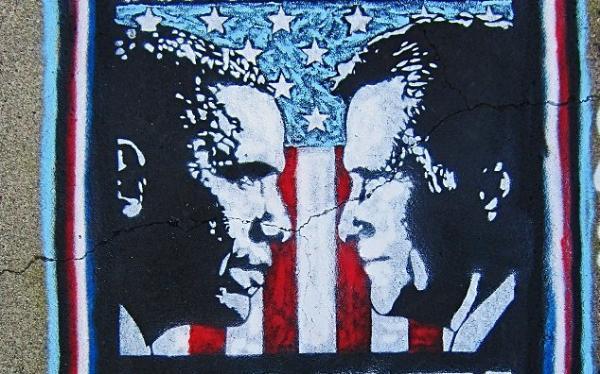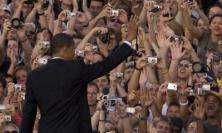As President Barack Obama and Mitt Romney prepare to meet in the first of three televised presidential debates, Michael Sean Winters analyses the campaigns of the candidates for the United States presidency. What effect has Bill Clinton’s speech at the Democratic National Convention had on the Obama campaign? How do Obama and Romney differ on economic policy? And to what extent will issues of religious liberty affect the results of the 2012 presidential election?
It was 2am on 15 July 1948. The Democratic National Convention had only confirmed, until that moment, the impression that President Harry S. Truman had no chance of being re-elected. Earlier in the week, after the party adopted a civil rights plank, three dozen southern delegates walked out, pledging to support a third party, segregationist candidate – which they did – leaving a weakened Democratic Party divided as well. Truman had wanted a young and vigorous running mate, but the convention chose 70-year-old Senator Alben Barkley instead. On the night of 14 July, the roll call voting had dragged on and on, so that Truman’s acceptance speech, scheduled for 10pm, now took place well after bedtime for most listeners. Everything from the polls to the timing seemed to spell doom for the Democrats.
‘Senator Barkley and I will win this election and make these Republicans like it – don’t you forget that,’ said Truman when he finally got to the microphone. The effect was electrifying. To a party resigned to defeat, Truman’s pugnacious opening line struck a chord of confident defiance and the convention delegates felt suddenly empowered to hope that all was not lost. Truman went on to lambaste the ‘do-nothing Republican Congress’ and contrast their inertia with the many promises in their party’s platform. He called their bluff, announcing a special session of Congress in which the Republicans could pass the laws they claimed they wanted. Truman, in one speech, changed the entire political trajectory of the election and he went on to win in November. No single convention speech since has had a similar effect.
Until last month. Former President Bill Clinton gave a speech at the Democratic National Convention, and using his vintage formula of mixing anecdotes with policy details, Clinton did for the president what Obama could not do for himself. Clinton reminded voters of just how lousy things were four years ago and said that no president, not even he, could have cleaned up the mess left by George W. Bush in only four years. If Obama were to say something similar, he would have opened himself to charges of self-pity, of failing to meet the demands of admittedly tough times, of whining. Coming from Clinton, the narrative worked and snippets from the speech are now a staple of the Obama campaign’s television adverts.
President Obama took office amidst an economic meltdown worse than any since the Great Depression. His 2008 campaign themes of ‘hope’ and ‘change’ were vague to begin with but, faced with the economic crisis, hope got set aside, change was deferred, and keeping the economy from going over the cliff edge took precedence. Worse, because so much of the economy is dependent upon consumer spending and confidence, Obama was reluctant to explain just how dire the situation was lest he spread the fear that had crippled investment and lending. He needed to reassure people at the same time as he was learning that the economy was actually in worse shape than grasped previously. Politically, unlike Franklin Roosevelt, who sought the presidency a full three years after the economic downturn of 1929, Obama had the further complication that while the plummet had started in September 2008, the pain was still only beginning to manifest itself when he took office in January 2009. That month, the U.S. economy shed some 750,000 jobs.
The effect of Clinton’s speech was akin to what happens when you are searching for your car keys and cannot find them. Your spouse reminds you that you wore a different jacket the night before and that the keys are doubtlessly there, and so they are. Before Clinton’s speech, Democrats had a hard time explaining why the economic recovery was so anaemic. Clinton said: well, the hole was so deep, it is taking longer to dig ourselves out than we might have thought. Car keys now in hand, Democrats left their convention in Charlotte with the same renewed confidence with which their forbears had left the 1948 convention in Philadelphia.
Clinton allowed the Democrats to say what they had had difficulty saying previously: yes, most Americans are better off economically under Obama than they were before. It turns out that most Americans still blame the economic meltdown on the Bush-era lack of Wall Street regulations and the unchecked greed of Wall Street itself. In addition, while the unemployment rate remains stubbornly above 8%, the 50% of Americans who have retirement plans in the stock market have seen their retirement accounts double in the past four years. Two-thirds of Americans are homeowners and they saw the value of their homes plummet during the 2008 economic meltdown; in recent months, home values have begun to climb again. And, in the key swing state of Ohio, the unemployment rate is a full percentage point lower than the national average.
There are many reasons for Ohio’s relatively strong economic performance in the past four years, but there is little doubt the economy in that state would be worse off if the Obama administration had not come to the rescue with government loans when the automotive industry almost followed Wall Street into the economic ditch. Although we associate the auto industry with the city of Detroit, Michigan, Ohio is riddled with small manufacturing centres that supply parts to the industry. At the time of the federal bailout, Governor Mitt Romney opposed the plan and even penned an op-ed entitled ‘Let Detroit Go Bankrupt.’ Romney argued that a bankruptcy proceeding would allow the industry to re-organise but, in fact, in 2009 there were no banks willing to restructure the loans. If the government had not stepped in, the U.S. auto industry would have collapsed.
The different responses of the two presidential contenders to the auto industry’s problems highlight perfectly their central difference on governing policy. President Obama believes that the federal government must work as a partner with the private sector, but a partner that insists that private companies abide by the environmental and labour rules that they resist. Gov. Romney believes in laissez-faire economic policy in which the government stands aside and lets the market determine all economic decision-making. The difference is rooted not only in the core attitudes of each party, but in each man’s experience: Obama the community organiser-turned-legislator versus Romney the venture capitalist-turned-governor.
Obama frames his governing approach in terms familiar to Catholics: the common good, mutual obligations, a robust social safety net. Romney frames his governing approach in more libertarian terms, arguing that government should unleash the freedom of the private sector and turn those government programmes that make up the social safety net into private sector programmes. In choosing Congressman Paul Ryan as his running mate, Romney highlighted his commitment to privatising Medicare, the federal programme that pays for the health care of the elderly. Currently, Medicare is a ‘guaranteed benefit’ programme: a senior citizen goes to the doctor and the doctor sends the bill to the government. It is the one sector of America’s otherwise Byzantine health care system that it akin to the UK’s National Health Service, a single payer system. Obama has sought to restrain the exploding costs of the programme by limiting health care cost increases across the board, a principal objective of his health care reform law. Romney has adopted Ryan’s proposal in which seniors would get an annual voucher with which they can purchase private health insurance on the free market. This year, they modified the proposal to allow seniors who wanted to keep the current guaranteed benefit system to do so. They believe the resulting competition would drive down costs. However, analysts have shown that insurance companies would cherry-pick the healthiest seniors, leaving the rest to stay on traditional Medicare. Filled with only very sick and mostly poor people, the Medicare programme’s costs per person would rise exponentially and become a target for future budget cuts.
Most campaign issues involve candidates using statistics selectively to paint their proposals in the best light. However, on issues relating to senior citizens, there is an acknowledged independent arbiter: The American Association of Retired Persons (AARP). As soon as an American turns 50, he or she is invited to join. The AARP provides discounts on a variety of things to its members. Its newsletters contain information on changes in the laws that affect seniors and other issues. The group lobbies Congress to protect programmes like Medicare and runs adverts defending their agenda. They have opposed the Romney-Ryan proposals on Medicare vigorously. In the six weeks that have passed since Romney chose Ryan as his running mate, Romney’s previous advantage among seniors has dwindled to a tie in most states. For Romney, this is ominous: President Obama has a huge lead among younger voters, so Romney needs to win the senior vote by about ten percentage points if he has any shot at winning Florida and Pennsylvania, the two states with the highest number of retired persons. Polls show him losing both states since he chose Ryan.
Why then did Romney choose Ryan? There were a variety of factors, to be sure, but one of them was that Ryan was the only Roman Catholic on the short list. Ever since President Obama announced in January that he would not exempt many Catholic institutions from a government mandate that their insurance policies cover contraceptive procedures, the Catholic bishops have sought to make religious liberty a central theme in the election. Romney no doubt hoped that his selection of a Catholic running mate would allow him to capitalise on any concerns raised among the Catholic population as a result of this. However, the issue has not resonated with most voters, including most Catholic voters. A Pew survey this summer, conducted after the bishops’ ‘Fortnight for Freedom’ – a two week long series of events designed to highlight the issue of religious liberty – indicated that only 22% of Catholics had heard ‘a lot’ about the issue and 42% had heard ‘a little.’ 56% of Catholics said they agreed with the bishops on the issue, but it was not enough to put them into the Romney-Ryan camp: Obama led among Catholics in the poll by a margin of 53% to 40%. Other polls since have shown Obama holding a similar lead consistently among Catholics.
To be sure, there are real religious liberty concerns in America – in public policy and in the courts. But some bishops have overplayed their hands. Bishop Daniel Jenky of Peoria, Illinois, delivered a sermon comparing Obama to Hitler and Stalin during the Fortnight for Freedom. Last month, Bishop Thomas Paprocki went out of his way, both in a widely publicised speech and in a column in his diocesan paper, to essentially tell Catholics they cannot vote for the Democrats. Such a forthright stance does not sit well with basic American, and Catholic, sensibilities.
One group of Catholics, however, will prove decisive in November. The Latino population is critical in four battleground states: Nevada, Colorado, Virginia and Florida. Latinos are supporting the president’s re-election efforts in overwhelming numbers. Polls show him winning by at least 2:1, similar to his margin in 2008. One poll this summer had Obama winning 70% of the Latino vote to Romney’s 22%. It is doubtful that Romney can do much to improve these numbers: during the primaries, he used his opposition to immigration reform to demonstrate his conservative credentials. He has opposed the DREAM Act, a proposal to allow those who were brought to the U.S. without documentation as children to apply for legal status provided they attended college or serve in the military. Undocumented immigrants, of course, cannot vote in the election because they are not citizens, but many Latino families have both documented and undocumented members. It is no coincidence that George W. Bush won re-election in 2004 in part because he garnered 44% of the Latino vote. Romney will be lucky to break 30%.
Politics is not science. Predictions are precarious. There is always a potential, proverbial banana skin waiting in the path of one’s opponent. Debates often can show a side of a candidate that forces the electorate to recalibrate. But, at the moment, President Obama looks to be winning the Catholic vote, and with it the presidency, by margins similar to those he achieved in 2008.
Michael Sean Winters is a journalist. He is the author of the ‘Distinctly Catholic’ blog and Left at the Altar: How the Democrats Lost the Catholics and How the Catholics Can Save the Democrats (Basic Books, 2008).
![]() Michael Sean Winters’ blog, ‘Distinctly Catholic’
Michael Sean Winters’ blog, ‘Distinctly Catholic’![]() Left at the Altar: How the Democrats Lost the Catholics and How the Catholics Can Save the Democrats by Michael Sean Winters
Left at the Altar: How the Democrats Lost the Catholics and How the Catholics Can Save the Democrats by Michael Sean Winters![]() ‘A Tale of Two Presidents’ by Michael Sean Winters on Thinking Faith
‘A Tale of Two Presidents’ by Michael Sean Winters on Thinking Faith![]() ‘The Health of a Nation’ by Vincent Rougeau on Thinking Faith
‘The Health of a Nation’ by Vincent Rougeau on Thinking Faith






